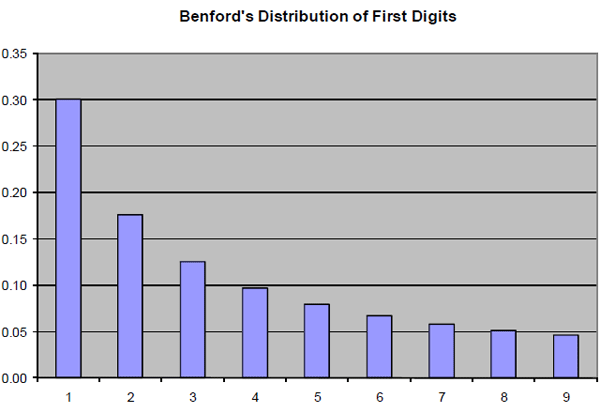About Frank Benford
I’m a grandson of the physicist Frank Benford for whom “Benford’s Law” is named. I like to think this shows that I have good genes.

I hold a Ph.D. in Applied Mathematics (Harvard University, 1978), and a Ph.D. in Economics (Carnegie Mellon University, 1994).
The Applied Math Program at Harvard asks incoming grad students to select a “field of substantive interest,” which can be almost anything. The student then splits his or her time between the study of that field and the study of the mathematical tools that can be applied to that field. My chosen field of substantive interest was population biology. Consequently, I took every course in ecology, evolution, biogeography, population genetics, and population models that Harvard offered, as well as a broad range of applicable math and statistics courses, including a course on computer simulation offered by MIT. I wrote a paper on Fisher’s theory of sex ratio applied to the social Hymenoptera (the ants, bees, and wasps) that was published in the Journal of Theoretical Biology. My Ph.D. dissertation describes a model of archipelago species composition based on MacArthur and Wilson‘s book The Theory of Island Biogeography.
After graduation, I took a position as an assistant professor in the Biomathematics Program at North Carolina State University. This gave me an opportunity to collaborate with faculty members in Statistics, Forestry, Entomology, Genetics, Zoology, and Economics. I developed a course based on Colin Clark‘s book Mathematical Bioeconomics.
During these years, my research interests shifted away from conventional population biology and into an area best described as “human ecology.” At the same time, I saw that to be a better environmentalist I needed to understand how economists think about the environment. When the opportunity arose I entered the Ph.D. program in economics at Carnegie Mellon University, where my research focused on natural resource and environmental economics. I’m particularly interested in the analysis and design of regulations that affect the interface between economic systems and the ecosystems in which they’re embedded. I published a paper on the North Carolina bay scallop fishery in Natural Resource Modeling, and a paper on the regulation of a persistent pollutant in the Journal of Environmental Economics and Management.
Although my research lies in fields outside of mathematics (e.g., ecological economics), my preference and forte as a teacher is to teach undergraduate mathematics. I have taught a very wide range of math and statistics courses at NCSU, Western Oregon University, and Willamette University.
In addition to working as a professor of mathematics, I’ve worked as a scientific programmer (with Roger Revelle, Harold Thomas, and Peter Rogers, among others) at the Harvard Center for Population Studies, and as an economist at the Forestry Sciences Laboratory, a branch of the Pacific Northwest Research Station of the USDA Forest Service located on the Corvallis campus of Oregon State University.

